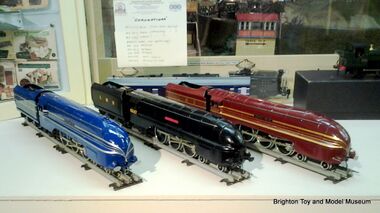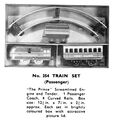Category:Coronation Class locomotives
This exhibit was on display between November 2012 and early 2013
Blueprints (nose, side) [image info]
Streamlined Coronation Class locomotives 6220 Coronation (blue and silver), 6229 Duchess of Hamilton (red and gold), and 6247 City of Liverpool (in wartime black), modern gauge 0 models by ACE Trains [image info]

Coronation Scot Exhibition
the locomotives
trains: 1937 - 1939 - 1940
greatest? - streamlining - advertising - trivia - models and kits
The streamlined LMS Coronation Class locos were introduced in 1937, and the first, 6220 Coronation, promptly broke the British speed record on her first public outing. They (and their "Duchess" variation) still hold the record for being the most powerful steam locomotives ever built for British track.
Classes and namings
After the success of the "Princess Royal" Class passenger locomotives, LMS accepted that a larger, faster, more powerful "Super-Princess" was needed, and Stanier set to work designing it. Where the "Princesses" had been "pretty" locomotives that had achieved a degree of elegance, the new beefed-up versions would be larger and heavier, and approach the limits for the size of loco that could fit through UK tunnels and trackworks.
Originally referred to as the "Princess Coronation" Class as a reference to the earlier design, the "Princess" prefix stopped being used as it became clear that the new streamliners, hauling the Coronation Scot, had achieved a reputation and identity very much their own, and didn't need a reference to their parent design to "sell" them. After the first ten streamliners, Stanier insisted that the next locos would be built "as nature intended", as conventional-looking engines, before returning to streamlined casings for the next batch of fifteen. The non-streamlined locos (and later, also the de-streamlined Coronations) were so looked so different that they ended up with their own Class name, the "Duchess" Class.
The streamlining
The first of the LMS Coronation/Duchess Class of 4-6-2 locomotives was the streamlined 6220 Coronation (1937), and thirty-eight of the locos were eventually built, in a range of liveries, with and without streamlining. The main design was based on William Stanier's Princess Royal Class.
The first batch of five streamlined Coronation Class locomotives (numbers 6220-6224) were designed in tandem with the carriages for the Coronation Scot train, in blue with silver striping that started at a point at the locomotive's nose, and extended down the entire length of the train. The first of this batch of locomotives, Coronation 6220, gave its name to the class.
For the second batch of five engines (6225-6229), LMS decided to use a version of their own crimson livery, and also changed the silver striping to gold. A prototype set of new and more luxurious carriages in the new livery was built and sent to the US for promotional purposes, but the outbreak of WW2 meant that no more were built, and the planned crimson version of the Coronation Scot never went into service in the UK.
Although the locomotives were mainly designed by Stanier, the streamlining was designed by Tom Coleman in Stanier's absence, and Stanier later decided that the performance improvements given by the streamlined shroud at high speeds wasn't worth the extra difficulty in getting access to the engines for servicing. Later batches of the locos were mostly built without the streamlined fairing, and the existing streamlined locos started to be stripped of their covers.
Britain's Fastest Steam Train (in 1937)
The Coronation/Duchess Class steam locomotives were the most powerful ever built for the UK rail network, and they were fast, with Coronation breaking the existing 116mph British speed record by one additional mile per hour in 1937.
Although the streamlined A4 "Mallard" locomotive (1938) pushed this to 126mph the next year, fans of the Coronation Class point out that Mallard's record-breaking attempt was carried out in favourable conditions and that the locomotive needed servicing afterwards due to its tendency to overheat at high speeds, whereas Coronation 6220 couldn't run any faster because of the track quality, and didn't need any special servicing after its successful record-breaking attempt.
The first ten locos
- Originally streamlined, blue with silver stripes
- 6220 Coronation // 6221 Queen Elizabeth // 6222 Queen Mary // 6223 Princess Alice // 6224 Princess Alexandria
- Originally streamlined, crimson with gold stripes
- 6225 Duchess of Gloucester // 6226 Duchess of Norfolk // 6227 Duchess of Devonshire // 6228 Duchess of Rutland // 6229 Duchess of Hamilton
Further locomotives were issued in a range of standard and experimental liveries (mostly black for those produced in the war-years, and green for later units, and a few blue units), and the later locomotives were issued in a mix of streamlined and non-streamlined formats. Streamlining was eventually dropped altogether, and the streamlined casings ended up being stripped from all the locos that still had them.
Preservation
- 6229 Duchess of Hamilton, the last of the ten original striped Coronation Class locos has since been re-fitted with a red and gold-striped streamlined casing for preservation and display at the National Railway Museum in York. This is the actual locomotive that toured the United States as "6220".
- 46233 Duchess of Sutherland, and 46235 City of Birmingham are preserved in a non-streamlined state.
See also:
- Duchess Class locomotives
External links
- Coronation Class locomotives: listing and specifications (railuk.info)
- Re-streamlining 6229 Duchess of Hamilton (tyseleylocoworks.co.uk)
- 6229 Duchess of Hamilton at the National Railway Museum (nrm.org.uk) - mostly pics before the streamlining was re-fitted
- LMS Princess Coronation Class (wikipedia.org)
Subcategories
This category has the following 2 subcategories, out of 2 total.
C
Pages in category ‘Coronation Class locomotives’
The following 12 pages are in this category, out of 12 total.
C
- Coronation 6220 locomotive paperweight, small (Bassett-Lowke)
- Coronation 6220 locomotive, blue (Trix Twin Railways, modified)
- Coronation locomotive 6220 (Bassett-Lowke)
- Coronation locomotive 6220 (Hornby R.685)
- Coronation locomotive 6220 (Hornby R.864)
- Coronation locomotive 6220 paperweight
- Coronation Scot US Tour presentation set 2/347 (Trix Twin Railways)
Media in category ‘Coronation Class locomotives’
The following 20 files are in this category, out of 20 total.
- Book TheDuchesses AndrewRoden.jpg 760 × 1,160; 87 KB
- Coronation 6220 locomotive, gauge 0 (ACE Trains).jpg 1,200 × 810; 401 KB
- Coronation 6220 wings (Meccano Magazine).jpg 1,150 × 1,069; 129 KB
- Coronation and West Country Class locos (Micromodels M2).jpg 3,000 × 2,121; 3.83 MB
- Coronation Class - blueprint, front.jpg 768 × 1,024; 137 KB
- Coronation Class locomotives 6220, 6247, 6229 (ACE Trains).jpg 1,024 × 575; 226 KB
- Coronation Scot display, Brighton Toy and Model Museum, November 2012.jpg 1,024 × 768; 335 KB
- Coronation Scot in the United States.jpg 1,205 × 1,624; 428 KB
- Coronation Scot US special-features p1.jpg 1,205 × 1,624; 405 KB
- Coronation Scot US special-features p2.jpg 1,205 × 1,624; 418 KB
- Coronation6220 blueprint side detail nose.jpg 1,728 × 2,355; 697 KB
- CoronationScot GOSV 35c 01.jpg 955 × 714; 106 KB
- CoronationScot GOSV 35c 02.jpg 953 × 711; 140 KB
- Duchess of Gloucester locomotive, LMS 6225 (Bassett-Lowke).jpg 2,200 × 1,469; 2.71 MB
- Locomotives, written by W.J. Bassett-Lowke, drawn by Paul. B. Mann.jpg 1,024 × 840; 133 KB
- MeccanoMagazine May1939 NewCoronationScot.jpg 480 × 647; 91 KB
- The Exhaust Steam Injector (Metcalfe's Patents).jpg 708 × 903; 143 KB
- The Prince, Streamlined Train Set, Wells Brimtoy 354 (BPO 1955-10).jpg 1,739 × 1,823; 965 KB
- Wonder Book of Railways (Coronation Scot), dustjacket.jpg 2,497 × 1,208; 638 KB
- Wonder Book of Railways (Coronation Scot), front.jpg 1,700 × 2,170; 543 KB
























